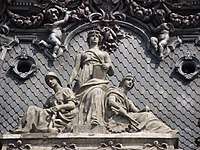Izrael Poznański Palace
The Izrael Poznański Palace (Polish: Pałac Izraela Poznańskiego) is a 19th-century palace in Łódź, Poland. Initially the site of a tenement building, the property was transformed into a Neo-Renaissance and Neo-baroque style residence during the years 1888 to 1903.[1]

History
The history of the palace goes back to the 1860s. It was during this time that Kalman Poznański, a Polish-Jewish trader from Kowal in the Kuyavia region, arrived and began to live in Łódź. Kalman started a cotton industry, but it was not successful. However, when the business was taken over by his son Izrael Poznański (1833–1900), there was a phenomenal rise in the price of cotton around the world. Izrael made a fortune from cotton and spent a large part of his earnings on the palace, which eventually took on his name.[2]
When Izrael Poznański acquired the site of the palace, there was a modest two-story building standing already. He renovated and expanded the building into a large residence. Taking his inspiration from the French neo-Renaissance, architect Hilary Majewski (and later Adolf Zeligson who modified the building)[3] designed a suitably lavish abode which was meant to be the residence of Poznański, one of the key industrialists that drove the textile revolution in Łódź. The palace was marked for its opulence and grand size, and distinguished itself from the surrounding residences.[4] The palace is also notable because of its L-shaped design. Another feature of the palace is the southern wing, which is topped with the tall domed roofs. It also included gardens filled with "botanical phenomena" so rare to the country that their Latin names had no Polish equivalent at the time, a shooting range and exteriors boasting majestic domes, fancy embellishments and sculptures representing allegories of industry.[5] Inside, a ballroom, a chamber of mirrors and a glass-ceilinged winter garden were also added to the labyrinthine layout.[6] The interior decoration of the large Dining Room as well as the Ballroom was designed by a renowned Łódź artist and painter Samuel Hirszenberg.[7]
Before the outbreak of World War II, members of the Poznański family emigrated to the Western Europe. During the German occupation, the palace served as headquarters of Nazi German authorities. After the war, the building served as the seat of the voivodeship office.[8]
Since 1975, the palace has housed the Museum of the City of Łódź (Muzeum Miasta Łodzi). The museum possesses rich collections of numismatics, iconography, painting, sculpture, graphics, books and manuscripts.[9]
In 2015, the palace was officially included on the List of Historic Monuments of Poland.[10] In 2017, the process of revitalization of the palace was initiated, and work began on renovating the palace's facade. Renovation of the palace was completed in 2020 on the 200th anniversary of "Modern Łódź" and the building "(has) regained its perch as one of the nation’s most magnificent urban structures."[11]
Gallery
 Izrael Poznański Palace in the 1950s
Izrael Poznański Palace in the 1950s_ID_613175.jpg) Entrance from the palace gardens
Entrance from the palace gardens Decoration detail
Decoration detail Interior
Interior
See also
References
- "Archived copy". Archived from the original on 2019-02-24. Retrieved 2016-01-07.CS1 maint: archived copy as title (link)
- http://culture.pl/en/place/the-museum-of-history-of-the-city-of-lodz
- Skrzydło, Leszek (1999). Rody fabrykanckie. Łódź: Oficyna Bibliofilów. p. 58. ISBN 83-87522-23-6.
- "The Louvre of Łódź: Once a faded jewel, Poznański Palace has regained its perch as one of the nation's most magnificent urban structures". Retrieved 28 February 2020.
- "Pałac Izraela K. Poznańskiego (obecnie Muzeum Miasta Łodzi)". Retrieved 5 April 2020.
- "The Louvre of Łódź: Once a faded jewel, Poznański Palace has regained its perch as one of the nation's most magnificent urban structures". Retrieved 4 April 2020.
- Szymański, Marcin; Torański, Błażej (2016). Fabrykanci. Burzliwe dzieje rodów łódzkich przemysłowców. Warsaw: Zona Zero. p. 103. ISBN 978-83-935847-8-9.
- "Pałac Izraela K. Poznańskiego (obecnie Muzeum Miasta Łodzi)". Retrieved 5 April 2020.
- "Pałac Izraela K. Poznańskiego (obecnie Muzeum Miasta Łodzi)". Retrieved 5 April 2020.
- "Prezydent Komorowski: - Łódzkie zabytki pomnikami historii". Retrieved 2019-03-10.
- "The Louvre of Łódź: Once a faded jewel, Poznański Palace has regained its perch as one of the nation's most magnificent urban structures". Retrieved 4 April 2020.
External links
| Wikimedia Commons has media related to Izrael Poznański Palace in Łódź. |